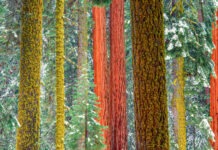From 8.16am to 2.44pm the planet Venus will cross the face of the sun, appearing as a tiny black speck to skygazers.
A Transit of a planet occurs when the planet passes directly between the Earth and the Sun so that as seen from the Earth, the planet appears to pass across the face of the Sun. Transits can only occur with planets whose orbit is between that of the Earth and the Sun; that is, Mercury and Venus. A transit of a planet is similar to a solar eclipse but the planet appears to be much smaller that the Moon so it cannot cover the Sun and looks like a small black disc slowly crossing the Sun.
The transit last occurred in 2004 but will not happen again until 2117. View an infographic of the rare Venus transit, which occurred in 2004.
For the transit of 6th June 2012, Venus will take about six and a half hours to travel across the face of the Sun. Venus must be above the horizon for the transit to be visible. Australia is one of the best places on Earth from which to observe the transit as the entire transit will be visible from eastern and central Australia. The transit will have started before sunrise for those observing from Western Australia.
The predicted path of Venus across the Sun’s disc is shown in the diagrams above for locations on the east coast of Australia. Venus will travel in a straight line in its orbit across the Sun. However, because the Sun appears to rotate as it crosses the sky, Venus will appear to move in an inverted “U” shape when viewed from Australia.
The original benefit of observing transits of Venus was to assist in determining the Astronomical Unit. Later on, transits were used to examine Venus’s atmosphere using spectroscopy. Currently there is a great deal of scientific effort directed towards the search for exoplanets (planets outside the Solar System) and planetary transits across distant stars are the main method used to search for them. The 2004 and 2012 transits of Venus are providing a valuable benchmark and comparison with a known planet transiting a known star.
Read more about the History of the Transit of Venus.
Checkout SPACE.com‘s Transit of Venus 2012: An Observer’s Guide (Gallery) and Photography Skywatching Guide.
Safe Viewing of the Transit
Events such as solar eclipses and transits are exciting to watch, but you must ensure that you use the safest methods of viewing them.
Read more about Safely viewing the Sun.
Never look directly at the Sun or you may cause serious and permanent damage to your eyesight. Damage can occur without any feeling that there is something wrong as there are no pain receptors in the retina and the damage may not become apparent for some time. There are several safe methods of observing the transit.
1. Observing using the Internet ninemsn is streaming it live in conjunction with Sydney Observatory a live video of the whole event will be broadcast on Transit of Venus Project website.
2. Projection using a SolarScope, Binoculars or a Telescope.
Click here for information on how to use these projection methods safely.
Source: Transit of Venus Australia 2012 – a joint educational project of the Surveying and Spatial Science Industry, the Astronomical Association of Qld (AAQ), the Science Teachers Association of Qld (STAQ),and contributing teacher and surveyor volunteers Australia-wide.

















